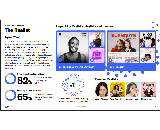SiriusXM has released a new pitch deck to the advertising buy side of online audio. It’s called CRL+Z (The Real Sound of Gen Z. It’s an advertiser guide to addressing what he presentation calls “this indefinable generation.” And, naturally, it is a promotion of SiriusXM’ experience and effectiveness in the field.
On that last point, Sirius claims to run the largest digital audio advertising ecosystem in North America, and bullets four key attributes:
- A leader in ad-supported scale and share of ear
- A reach of over half of Gen Z
- The most valuable audiences (education level and affluence are specified in this one)
- An “audience-minded team”
A four-part network
Sirius is really promoting four components of its stand-alone network, that it has grown or acquired over years.
- SiriusXM Streaming Network
- SoundCloud (which SiriusXM partially owns after a $75 million investment in 2020) [RAIN HERE]
- Pandora (which SiriusXM acquired in 2019) [RAIN [HERE]
- The SiriusXM Podcast Network (no specific launch date)
The diverse characteristics of Gen Z
SiriusXM identifies, defines, and characterizes three types of Gen Z consumer, as if it were typecasting bohemian artists in a French movie:
- The Wanderer (age 13-17)
- The Connoisseur (age 18-24)
- The Realist (age 25-29)
Each of these (sociocultural?) groups is editorially defined, and also assigned typically popular radio stations, podcasts, and podcasters. (Example below.)
After each of these defining slides, there follows a “How to reach [whichever group]” page — streaming? podcast advertising? omnichannel? — with plenty of research detail about how these consumer groups prefer to be addressed. The survey detail is impressive in these pages.
These is a special cheat sheet for advertisers to reach diverse Gen Z’ers. And the generational group is further examined in ethno-cultural group: Asian Pacific, Black, Hispanic.
Naturally, Sirius XM i promoting its expertise, products, and results. “We have he receipts,” the company asserts in one summary of a case study:
Sources
Sources are cited for each slide in this deck. They include Edison Research, Comscore Media, MIR-Simmons Local Studios, Pandora internal metrics, Global Web Index, Audiomack, idbi Media Kit, Soundcloud data, Disqo, Cmscore, Pew Research Center, and Lucid. As always, we recommend the original source, which is HERE.

